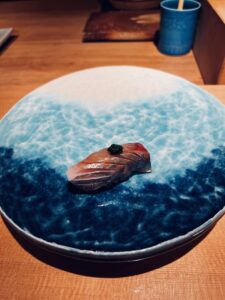Solving a Sushi Chef’s Struggle: My Battle with Sticky Sushi Rice
Hello everyone, this is Sushi Hatake! Today, I’d like to talk about an unexpected challenge sushi chefs face: “the problem of sushi rice sticking to your hands.” As someone still in training, I’ve been battling this issue every day—and today, I’d like to share my experience and some strategies I’ve been trying.
Why does sushi rice stick to your hands?
I currently work at “Sushikawa” in Sasazuka, handling the dinner service on Tuesdays and Wednesdays. Lately, I’ve been struggling with rice sticking to my hands in the middle of making nigiri. Especially during the later part of the dinner shift, it gets harder and harder to shape the sushi.
After some research, I found out that the ideal temperature for a sushi chef’s hands is said to be around 30°C (86°F). If your hands are warmer than that, the starch on the surface of the rice becomes stickier and more prone to clinging.
When I measured my own hand temperature, it was around 33°C (91.4°F) even at rest. And during service, as I keep working, my hands get even warmer due to increased blood circulation. That’s why, as the night goes on, I find it harder to keep the rice from sticking.
Professional techniques to prevent sticky rice
Currently, I’m trying out two main strategies to tackle this problem.
1. Adding ice to the hand water
I keep a bowl of “temizu” (hand water used to moisten the hands) next to the counter and fill it with plenty of ice. By dipping my hands into the ice water, I can temporarily lower their temperature. This is an essential trick, especially during the summer.
2. Adding ice to the vinegar water
I also add ice to the “tezu” (vinegar water used to coat the hands to prevent rice from sticking) to keep it nice and cold. Using chilled vinegar water helps maintain an optimal surface temperature for my hands while I’m making sushi.
Thanks to these methods, I’ve been able to get through even the later hours of dinner service. I imagine professional sushi chefs have internalized this temperature management through years of experience.
How seasons affect the art of sushi
Interestingly, how easy it is to make sushi changes with the seasons. In winter, my hands naturally stay cooler, so my nigiri is much faster in the cold months! (laughs)
In contrast, during summer, both my hands and the room are warmer, making the rice much more prone to sticking. For sushi chefs—especially for me—this is surprisingly challenging.
The shared “sense of touch” between farming and sushi making
Back when I was a farmer growing vegetables, the sense of touch in my hands was extremely important. Feeling the soil’s texture, the firmness of the leaves, the ripeness of the fruit—everything was sensed through my hands.
Now, as a sushi chef, I’ve realized that this “sense of touch” is just as vital when handling fish or shaping rice. Whether farming or cooking, both professions are about engaging with nature and having a dialogue with ingredients.
I’ll continue honing my craft so that I can always deliver delicious sushi, no matter the circumstances. I hope to use my background in farming to bring out the natural flavors of each ingredient, and become a sushi chef who truly honors the materials.
Offering authentic Edomae sushi in Tokyo
I provide a private sushi catering service throughout Tokyo, preparing each piece with care and attention to seasonal ingredients and temperature. Please enjoy my authentic Edomae-style sushi, crafted one by one with heart.
I’m also happy to accommodate English-speaking guests. Leave it to Sushi Hatake to create an unforgettable sushi experience for you!
We’re currently accepting bookings for sushi-making workshops as well. Why not experience the challenge of rice sticking to your hands firsthand—and step into the world of a sushi chef? I look forward to sharing delicious Edomae sushi and a fun, memorable time with you!


